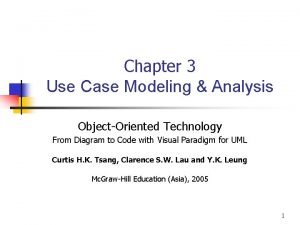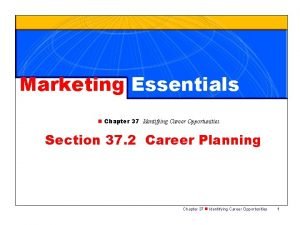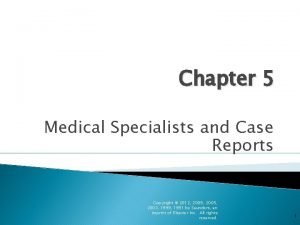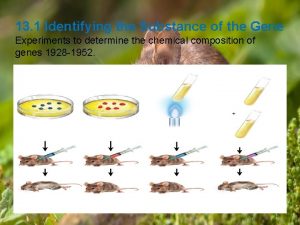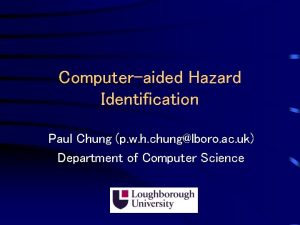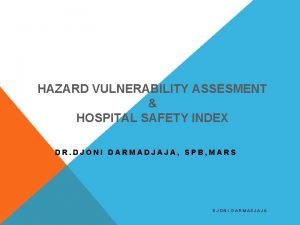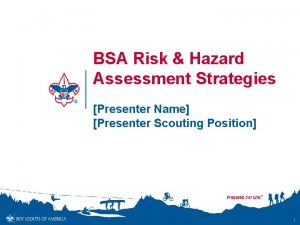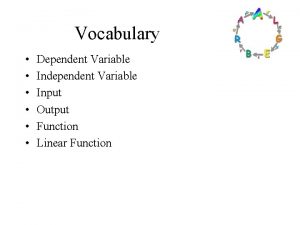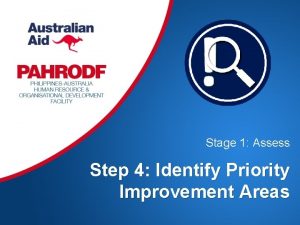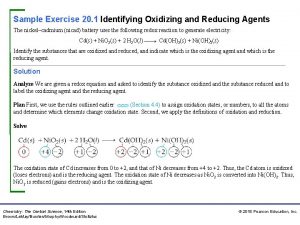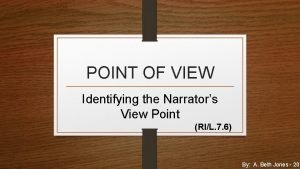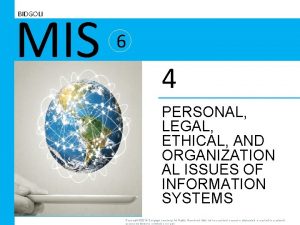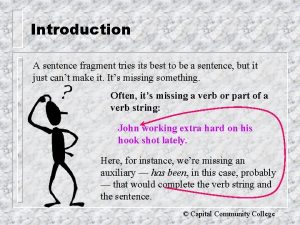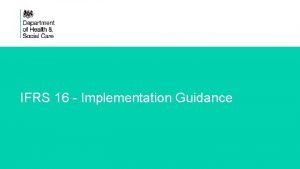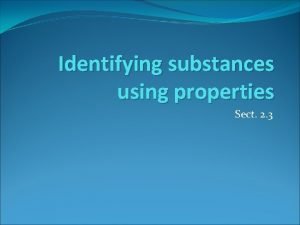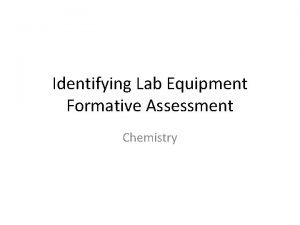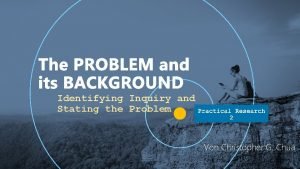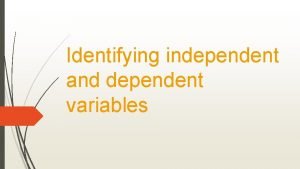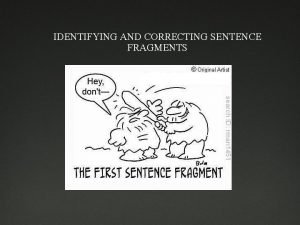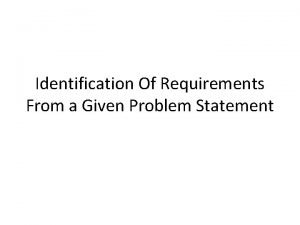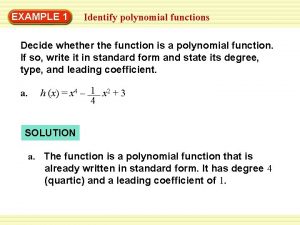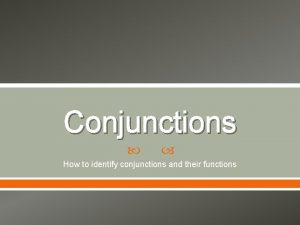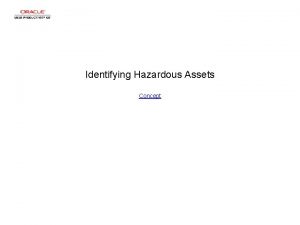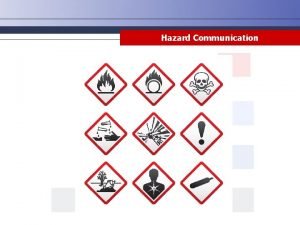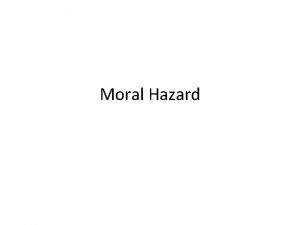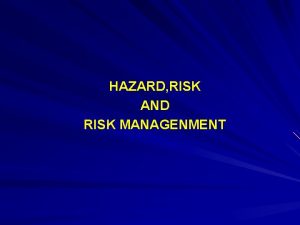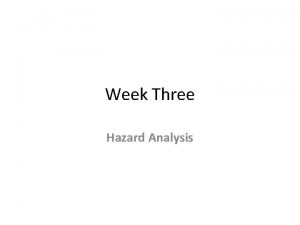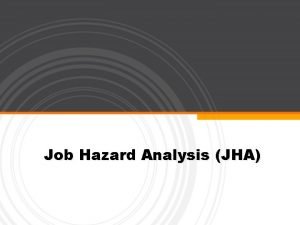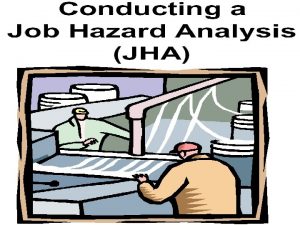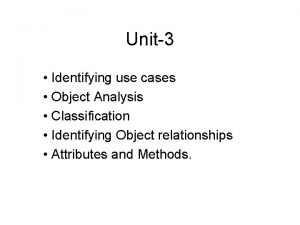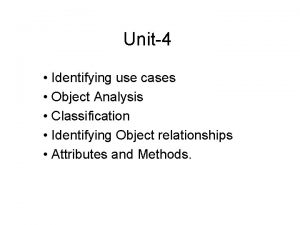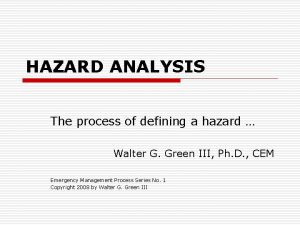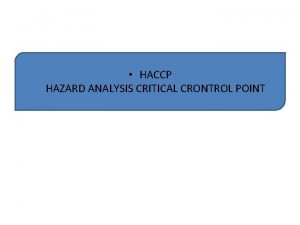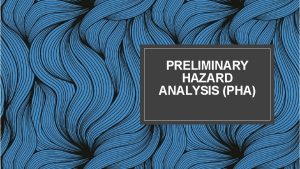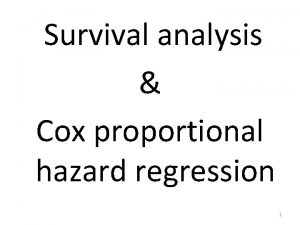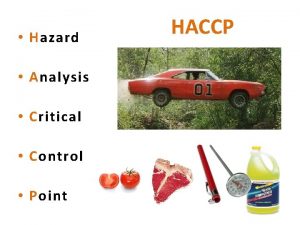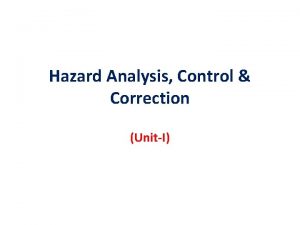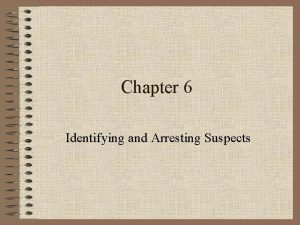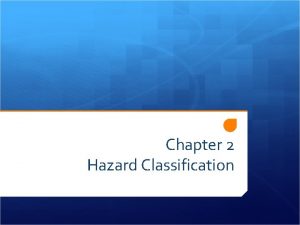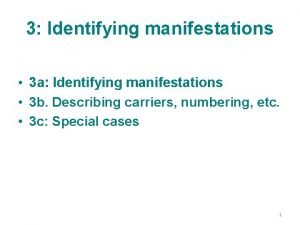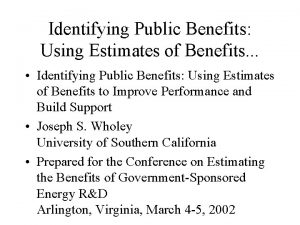IDENTIFYING HAZARD Chapter 6 HAZARD ANALYSIS l Hazard





















































- Slides: 53

IDENTIFYING HAZARD Chapter 6

HAZARD ANALYSIS l Hazard analysis has proven to be an excellent tool to identify and evaluate hazards in the workplace. l Written analysis often serve as the basis for more thorough inspections. Management can request a formal, written analysis for each critical operation. Such analysis not only gather information for immediate use, but they also obtain benefits over the long run. l For instance, once important hazard data are committed to a paper, they become part of the technical information base of the organization. These documents show the employer's concern for locating hazards and establishing corrective measures before an accident happens.

What Is Hazard Analysis? l Hazard analysis is an orderly process used to acquire specific hazard and failure data relevant to a given system. The method forces those conducting the analysis to ask the right questions and helps to answer them. l By locating those hazards that are the most probable or have the severest consequences, hazard analyses provide information needed to establish effective control measures. l Analytic techniques assist the investigator in deciding what facts to gather, determining probable causes and contributing factors, and arranging orderly clear results.

What are some uses for hazard analysis? l l l It can uncover hazards that have been unnoticed in the original design, or setup of a particular process, operation, or task. It can locate hazards that developed after a particular process, operation, or task was instituted. It can determine the essential factors and requirements for specific job processes, operations, and tasks. It can indicate what qualifications are prerequisites to safe and productive work performance. It can indicate the need for modifying processes, practices, operations, and tasks. It can identify situational hazards in facilities, equipment, tools, materials, and operational events (for example, unsafe conditions).

l l l It can identify ergonomic situations through work design (for example, work table heights, chairs, reaching capabilities). It can identify work practices responsible for accident situations (for example, deviations from standard procedures). It can identify exposure factors that contribute to injury and illness (such as contact with hazardous substances, materials). It can identify physical factors that contribute to accident situations (noise, vibration, insufficient illumination). It can determine appropriate monitoring methods and maintenance standards needed for safety. It can determine the possible results of failures/ accidents, the persons or property exposed to loss, and the potential severity of injury or loss.

Choosing a Method l To decide what hazard analytical approach is best for a given situation, the hazard control specialist will answer five questions: 1. What is the quantity and quality of information desired? 2. What information already is available? 3. What is the cost of setting up and conducting analyses? 4. How much time is available before decisions must be made and action taken? 5. How many people are available to assist in the hazard analysis, and what are their qualifications?

Who Should Participate in Hazard Analysis? l A hazard analysis, to be fully effective and reliable, should represent as many different viewpoints as possible. Each person familiar with a process or operation has acquired insights concerning problems, faults, and situations that can cause accidents. l These insights need to be recorded, along with those of the person initiating the hazard analysis usually the safety professional. Input from workers and employee representatives can be extremely valuable at this stage.

What Factors Need to Be Analyzed? l l l All machines, equipment, processes, operations, and tasks in any establishment or facility are good candidates for hazard analysis because they have the potential to cause accidents. Eventually, hazard analysis should be completed for all jobs, but the most potentially threatening should have immediate attention. In determining which processes, operations, and tasks receive priority, those making the decisions should take the following factors into consideration:

l Frequency of Accidents. Any operation or task with an associated history of repeated accidents is a good candidate for analysis, especially if different employees have the same kind of accident while performing the same operation or task. l Potential for Injury. Some processes and operations can have a low accident frequency but a high potential for major injury (for example, tasks on a grinder conducted without a tool rest or guard). l Severity of Injury. A particular process, operation, or task can have a history of serious injuries and be a worthy candidate for analysis, even if the frequency of such injuries is low.

New or Altered Equipment, Processes, and Operations l l l As a general rule, whenever a new process, operation, or task is created or an old one altered (because of machinery, equipment, or other changes), the safety professional or supervisor should conduct a hazard analysis. For maximum benefit, the hazard analysis should be done while the process or operation is in the planning stages. No equipment should be put into regular operation until the safety professional has checked it for hazards, studied its operation, installed any necessary additional safeguards, and developed safety instructions or procedures. Sticking to such a procedure ensures that managers can train employees in hazard controlled, safe operations and help to prevent serious injuries and exposures.

Excessive Material Waste or Damage to Equipment l Processes or operations producing excessive material waste or damage to tools and equipment are candidates for hazard analysis. The same problems causing waste or damage could also, given the right situation, cause injuries. l One of the first steps in hazard and accident analysis is performing job safety analyses. It can be specifically tailored to individual jobs or categories of jobs in the workplace.

JOB SAFETY ANALYSIS l Job safety analysis (JSA) is a procedure used to review job methods and uncover hazards that 1. may have been unnoticed in the layout of the facility or building and in the design of the machinery, equipment, tools, workstations, and processes; 2. may have developed after production started; 3. resulted from changes in work procedures or personnel.

Benefits of JSA The principal benefits of a JSA include: 1. 2. 3. 4. 5. 6. 7. giving individual training in safe, efficient procedures making employee safety contracts instructing the new person on the job preparing for planned safety observations giving pre job instruction on irregular jobs reviewing job procedures after accidents occur studying jobs for possible improvement in job methods. A JSA can be done in three basic steps. However, before initiating this analysis, management must first carefully select the job to be analyzed.

Selecting the Job l A job is a sequence of separate steps or activities that together accomplish a work goal. Selection of jobs to be analyzed and establishment of the order of analysis should be guided by the following factors: Frequency of Accidents. The greater the number of accidents associated with the job, the greater its priority claim for a JSA. Rate of Disabling Injuries. Every job that has had disabling injuries should be given a JSA, particularly if the injuries prove that prior preventive action was not successful. Severity Potential. Some jobs may not have a history of accidents but may have the potential for producing severe injury. New Jobs. Changes in equipment or in processes obviously have no history of accidents, but their accident potential may not be fully appreciated. A JSA of every new job should be made as soon as the job has been created. Analysis should not be delayed until accidents or near misses occur.

After the job has been selected, the three basic steps in making a JSA are: 1. Break the job down into successive steps or activities and observe how these actions are performed. 2. Identify the hazards and potential accidents. This is the critical step because only an identified problem can be eliminated. 3. Develop safe job procedures to eliminate the hazards and prevent the potential accidents. Breaking the Job Down into Steps Before the search for hazards begins, a job should be broken down into a sequence of steps, each describing what is being done.

Identifying Hazards and Potential Accident Causes l l The purpose is to identify all hazards both those produced by the environment and those connected with the job procedure. Each step, and the entire job, must be made safer and more efficient. Ask these questions about each step: l l Is there a danger of striking against, being struck by, or otherwise making harmful contact with an object? Can the employee be caught in, by, or between objects? Is there a potential for a slip or trip? Can the employee fall on the same level or to another? Can strain be caused by pushing, pulling, lifting, bending, or twisting? Is the environment hazardous to safety or health? For example, are there concentrations of toxic gas, vapor, mist, dust, heat, or radiation?

Identifying Hazards and Potential Accident Causes…………… The job observation should be repeated as often as necessary until all hazards and potential causes for accident or injury have been identified. l l l l l When inspecting a particular machine or operation, ask the question, "Can an accident occur here? " More specific questions include: Is it possible for a person to come in contact with any moving piece of machine equipment? Is it possible to be drawn into the in running nip point between two moving parts, such as a belt, chain, pressure rolls, rack and gear? Do machines or equipment have respond movement or any motion where workers can be caught on or between a moving part and a fixed object? Is it possible for a worker's hands or arms to make contact with moving parts at the point of operation where milling, shaping, punching, shearing, bending, grinding, or other work is being done? Is it possible for material (including chips or dust) to be kicked back or ejected from the point of operation, injuring someone nearby? Are machine controls safeguarded to prevent unintended operation? Are machine controls located to provide immediate access in the event of an emergency? Do machines vibrate, move, or walk while in operation?

Identifying Hazards and Potential Accident Causes…………. . l l l l l Is it possible for parts to become loose during operation, injuring operators or others? Is it possible for workers to bypass the guard, thereby making it ineffective? Is there sufficient room for maintenance and repair? Are the materials handling methods adequate for the work in process and the tooling associated with it? Is the work area well illuminated with specific point of operation lighting where necessary? Is ventilation adequate, particularly for those operations that create dusts, mists, vapors, and gases? Is the operator using personal protective equipment? Is housekeeping satisfactory with no tripping hazards or spills on the floor? Are energy sources controlled for maintenance?

Identifying Hazards and Potential Accident Causes…………. . l All of these questions will be of most value if they are incorporated into an inspection form that can be filled out at regular intervals. l Even though a question may not at first seem to apply to a specific operation, on closer inspection it may be found to apply. Using a checklist is a good way to make sure nothing is overlooked. l Again, check with the observed employee after the hazards and potential causes of accidents have been recorded. The experienced employee will probably offer additional suggestions. You should also check with others experienced with the job.

Developing Solutions l The final step in a JSA is to develop a recommended safe job procedure to prevent the occurrence of accidents. The principal solutions are as follows: 1. 2. 3. l l Find a new way to do the job. Change the physical conditions that create the hazards. Change the work procedure. To find an entirely new way to do a job, determine the work goal of the job, and then analyze the various ways of reaching this goal to see which way is safest. If a new way cannot be found, then ask this question about each hazard and potential accident cause listed "What change in physical condition (such as change in tools, materials, equipment, layout, or location) will eliminate the hazard or prevent the accident? " To investigate changes in the job procedure, ask the following questions about each hazard and potential accident cause listed: l "What should the employee do or not do – to eliminate this particular hazard or prevent this potential accident? " "How should it be done? " Because of his experience, in most cases the supervisor can answer these questions.

INSPECTION l Inspection should be conducted in an organization to locate and report existing and potential unsafe conditions or activities that, if left uncontrolled, have the capacity to cause accidents in the workplace. Philosophy behind Inspection l Inspection can be viewed negatively or positively as either: 1. 2. fault finding, with the emphasis on criticism fact finding, with the emphasis on locating hazards that can harmfully affect safety and health Purpose of Inspection l The primary purpose of inspection is to detect potential hazards so they can be corrected before an accident occurs. l Inspection can determine conditions that need to be corrected or improved to bring operations up to acceptable standards, both from safety and operational standpoints. l Secondary purposes are to improve operations and thus to increase efficiency, effectiveness, and profitability

Types of Inspection l Inspection can be classified as one of two types continuous or interval inspection. Continuous Inspection l This process is conducted by employees, supervisors, and maintenance personnel as part of their job responsibilities. l Continuous inspection involves noting an apparently or potentially hazardous condition or unsafe procedure and either correcting it immediately or making a report to initiate corrective action. Continuous inspection of personal protective equipment is especially important. l This type of inspection is sometimes called informal because it does not match to a set schedule, plan, or checklist. The truth is that both continuous and interval inspections are necessary and complement one another. l As part of their job, supervisors make sure that tools, machines, and equipment are properly maintained and safe to use and that safety precautions are being observed. l Tool room employees regularly inspect all hand tools to be sure that they are in safe condition. Foremen are often responsible for continuously monitoring the workplace and seeing that equipment is safe and that employees are observing safe practices. When foremen or supervisors inspect machines at the beginning of a shift, a safety inspection must be part of the operation

Interval Inspections l Planned inspections at specific intervals are what most people regard as "real" safety and health inspections. They are purposeful, thorough, and systematic procedures that permit examination of specific items or conditions. l They follow an established procedure and use checklists for routine items. These inspections can be any one of three types: periodic, intermittent, and general. l Periodic inspection includes those inspections scheduled at regular intervals. They can target the entire facility, a specific area, a specific operation, or a specific type of equipment. l Management can plan these inspections weekly, monthly, semiannually, or at other suitable intervals.

Periodic inspections can be of several different types: l l Inspections by the safety professional, industrial hygienist, and joint safety and health committees. Inspections for preventing accidents and damage or breakdowns (checking mechanical functioning, lubricating) performed by electricians, mechanics, and maintenance personnel. Inspections by specially trained certified or licensed inspectors, often from outside the organization (for example, inspection of boilers, elevators, cranes, power presses, fire extinguishing equipment). Inspections done by outside investigators or government inspectors to determine compliance with government regulations. The advantage of periodic inspection is that it covers a specific area and allows detection of unsafe conditions in time to provide effective countermeasures.

Intermittent inspections are those made at irregular intervals. l Sometimes the need for an inspection is indicated by accident tabulations and analysis. If a particular department or location shows an unusual number of accidents or if certain types of injuries occur with greater frequency, the supervisor or manager should call for an inspection. l When construction or remodeling is going on within or around a facility, an unscheduled inspection may be needed to find and correct unsafe conditions before an accident occurs. l The same is true when a department installs new equipment, institutes new processes, or modifies old ones.

PLANNING FOR INSPECTION An effective safety and health inspection program requires the following: 1. sound knowledge of the facility 2. knowledge of relevant standards, regulations, and codes 3. systematic inspection steps 4. a method of reporting, evaluating, and using the data. l An effective program begins with analysis and planning. If inspections are casual, superficial, and careless, the results will reflect the method. l Before instituting an inspection program, these five questions should be answered: 1. 2. 3. 4. 5. What items need to be inspected? What aspects of each item need to be examined? What conditions need to be inspected? How often must items be inspected? Who will conduct the inspection?

Hazard Control Inspection Inventory l To determine what factors affect the inspection, a hazard control inspection inventory can be conducted. l Management should divide the entire facility yards, buildings, equipment, machinery, vehicles into areas of responsibility. These areas, once determined, should be listed in an orderly fashion. l The analyst might develop a color coded map or floor plan of the facility. Large areas or departments can be divided into smaller areas and assigned to each first line supervisor and/or the hazard control department's inspector.

What Items Need to Be Inspected? Once specific areas of responsibility have been determined, managers should develop an inventory of those items that may become unsafe or cause accidents. These would include: l environmental factors (illumination, dust, fumes, gases, mists, vapors, noise, vibration, heat, radiation sources) l hazardous supplies and materials (explosives, flammables, acids, toxic or nuclear materials or by products) l production and related equipment (mills, shapers, presses, borers, lathes) l power source equipment (steam and gas engines, electrical motors) l electrical equipment (switches, fuses, breakers, outlets, cables, extension and fixture cords, grounds, connectors, connections) l hand tools (wrenches, screwdrivers, hammers, power tools) l personal protective equipment (hard hats, safety glasses, safety shoes, respirators, hearing protection, gloves, etc. ) l showers, eyewash fountains, first aid supplies, stretchers) l working surfaces (ladders, scaffolds, catwalks, platforms)

What Items Need to Be Inspected? . . . . l l l l l fire protection and emergency response equipment (alarms, water tanks, sprinklers, standpipes, extinguishers, hydrants, hoses, self contained breathing apparatus, toxic cleanup, automatic valves, horns, phones, radios) walkways and roadways (ramps, docks, sidewalks, walkways, aisles, vehicle ways, escape routes) elevators, electric stairways, and man lifts (controls, wire ropes, safety devices) material handling equipment (cranes, conveyors, hoists, forklifts, chains, ropes, slings) transportation equipment (automobiles, railroad cars, trucks, front end loaders, helicopters, motorized carts) warning and signaling devices (sirens, crossing and blinker lights, klaxons, warning signs, exit signs) containers (scrap bins, barrels, drums, gas cylinders, solvent cans) storage facilities and areas both indoor and outdoor (bins, racks, lockers, cabinets, shelves, tanks, closets) structural openings (windows, doors, stairways, sumps, shafts, pits, floor openings) buildings and structures (floors, roofs, walls, fencing) miscellaneous any items that do not fit in preceding categories.

What Aspects of Each Item Need to Be Examined? l l Particular attention should be paid to the parts of an item most likely to become a serious hazard to health and safety. These parts often develop problems because of stress, wear, impact, vibration, heat, corrosion, chemical reaction, and misuse. Such items as safety devices, guards, controls, work or wear point components, electrical and mechanical components, and fire hazards tend to become unsafe first. For a particular machine, critical parts would include the point of operation, moving parts, and accessories (flywheels, gears, shafts, pulleys, belts, couplings, chains, controls, lighting, brakes, exhaust systems). Also to be checked are items related to feeding, oiling, adjusting, maintenance, grounding, attaching, work space, and location.

What Conditions Need to Be Inspected? l l l The unsafe conditions for each part to be inspected should be described specifically and clearly. Inspectors should describe and not simply list unsafe conditions for each item. Usually, conditions to look for can be indicated by such words as "uneven, exposed, broken, worn, leaking, rusted, corroded, missing, vibrating, loose, ". Checklists serve as reminders of what to look for and as records of what has been covered. They can be used to structure and guide inspections. Good checklists also help in follow up work to make sure hazards have been corrected or eliminated. Checklists can be prepared by the safety and health committee, by the safety director, or by a subcommittee that includes engineers, supervisors, employees, and maintenance personnel. Choosing the inspection route means inspecting an area completely and thoroughly while avoiding: 1. 2. 3. 4. time consuming backtracking and repetitions long walks between items unnecessary interruptions of the production process interruption of employees.

How Often Must Items Be Inspected? l The frequency of inspection is determined by four factors. What is the loss severity potential of the problem? The inspector should ask, "If the item or critical part should fail, what injury, damage, or work interruption would result? " The more severe the loss potential, the more often the item should be inspected. What is the potential for injury to employees? If the item or critical part should fail, how many employees would be endangered and how frequently? The greater the probability for injury to employees, the more often the item should be inspected. How quickly can the item or part become unsafe? The answer to this question depends on the nature of the part and the conditions to which it is subjected. Equipment and tools used frequently can become damaged, defective, or worn more quickly than those rarely used. What is the past history of failures? What were the results of these failures? Maintenance and production records and accident investigation reports can provide valuable information about how frequently items have failed and the results in terms of injuries, damage, delays, and shutdowns. The more often an item has failed in the past and the greater the consequences, the more it needs to be inspected.

Who Will Conduct the Inspection? l l l No individual or group should have exclusive responsibility for all inspections. Employees who perform these inspections will benefit from training in hazard recognition. Some items will need to be inspected by more than one person. For example, while an area supervisor may inspect an overhead crane weekly and maintenance personnel inspect it monthly, the operator of the crane will inspect it before each use. When grinding wheels are received, they are inspected by the stockroom attendant, but they must be inspected again by the operator before each use. As part of the hazard control inspection inventory, management should assign responsibility for each inspection. A suggested guide for planned inspections is as follows: l l Daily area supervisor and maintenance personnel, who also can request suggestions from employees in their various workstations Weekly department heads Monthly supervisors, department heads, the safety department, and safety and health committees. The safety department also may be actively involved in monthly, quarterly, semiannual, and annual inspections.

Five qualifications of a good inspector are: 1. 2. 3. 4. 5. knowledge of the organization's accident experience familiarity with accident potentials and with the standards that apply to his area ability to make intelligent decisions for corrective action diplomacy in handling personnel and situations knowledge of the organization's operations its workflow, systems, and products. Safety Professionals l l The number of safety professionals depends on the size of the company and the nature of its operation. Large companies with well organized accident prevention programs usually employ a full time staff. In organizations where toxic and corrosive substances are present, the industrial hygienist will be part of the inspection team.

Company or Facility Management l Safety inspections should be considered part of the duties of company or facility management. By participating in inspections, management demonstrates its commitment to maintain a safe working environment. First line Supervisor or Foreman l Because supervisors and foremen spend practically all their time in the shop or facility, they continuously monitor the workplace. At least once a day, supervisors need to check their areas to see that 1. 2. 3. 4. 5. employees are complying with safety regulations, guards and warning signs are in place, tools and machinery are in a safe condition, aisles and passageways are clear and proper clearances maintained, material in process is properly stacked or stored.

Employees l Before beginning the workday, the employee should inspect the workplace and any tools, equipment, and machinery that will be used. l Any defects the employee is not authorized to correct should be reported immediately to the supervisor. Action resulting from this report must be reported to the employee to encourage further participation. Maintenance Personnel l Maintenance employees can be of great help in locating and correcting hazards. As they work, they can conduct informal inspections and report hazards to the supervisor, who in turn should encourage the mechanics to offer suggestions. Other Inspection Teams l Management should assign an inspection team that includes the hazard control specialist, production manager, supervisor; employee representative, fire prevention specialist, and industrial hygienist. l Outside inspectors sometimes are needed to perform inspections. For example, insurance company safety engineers and local, state or provincial, and federal inspectors may lend their expertise to specific inspections.

CONDUCTING INSPECTIONS l Companies must not only conduct regular inspections but carry them out in a way that emphasizes the company's commitment to safety. Preparing to Inspect l Inspections should be scheduled for times when inspectors will have the best opportunity to see operations and work practices without much interruption. The inspection route should be planned in advance. l Before conducting an inspection, the inspector or inspection team should review all accidents that have occurred in the area. At this brief meeting, team members should discuss where they are going and what they will be looking for. l During the inspection, before going into noisy areas, the team will need to discuss what they wish to accomplish in order to avoid arm waving, shouting, and other unsatisfactory methods of communication. l In addition to the regular checklist and accident reports, inspectors should have copies of the previous inspection report for that particular area. Reviewing this report makes it possible to check whether earlier recommendations have been followed and reported hazards corrected. l Those making inspections should wear the protective equipment required in the areas they enter: safety glasses and shoes, hard hats, acid proof goggles, protective gloves, respirators, and so forth. l If inspectors do not have or cannot get special protective equipment, they should not go into the area. They must be careful to "practice what they preach. "

Inspection Tools l Inspectors should have the proper tools ready before the inspection to make the process more efficient and to gather more precise data. Common tools include: 1. 2. 3. 4. 5. 6. l clipboards inspection forms pens/pencils lockout/tagout supplies measuring tape/ruler flashlight. Depending on the inspection area or type, the following equipment may also be useful: 1. 2. 3. 4. 5. 6. 7. 8. cameras tape recorder electrical testing equipment sampling devices (air, noise, light, temperature) sample containers calipers, micrometers, antenna gauges special personal protection equipment stopwatch.

Relationship of Inspector and Supervisor l l l Before inspecting a particular department or area, the inspector should contact the department head, supervisor, or other person in charge. This person may have important information for the inspection, particularly if conditions are temporarily altered because of construction, maintenance, equipment downtime, employee absence, and so forth. If the supervisor of the area does not accompany the inspector, the supervisor should be consulted before the inspector leaves the area. Relationship of Inspector and Employee l If not company policy or departmental rules prohibit conversation with employees, the inspector can ask questions about operations taking care, however, not to take over the responsibility of the supervisor.

MEASUREMENT AND TESTING Kinds of Measurement and Testing l Occupational health observation monitors chemical, physical, biological, and ergonomic hazards. Four monitoring systems are used: personal, environmental, biological, and medical. Personal Monitoring l One example of personal monitoring is measuring the air borne concentrations of contaminants. The measurement device is placed as closely as possible to the site at which the contaminant enters the human body. l When the contaminant is noise, the device is placed close to the ear. When a toxic substance could be inhaled, the device is placed in the breathing zone. Environmental Monitoring l Environmental monitoring measures contaminant concentrations in the workroom. The measurement device is placed in the general area adjacent to the worker's usual workstation or where it can sample the general room air. Biological Monitoring l Biological monitoring measures changes in composition of body fluid, tissues, or expired air to detect the level of contaminant absorption. l For example, blood or urine can be tested to help determine lead exposures. Similarly, the phenol in urine sometimes is measured to document benzene exposure.

Medical Monitoring l l When medical personnel examine workers to see their physiological and psychological response to a contaminant, the process is termed medical monitoring. Medical monitoring can include health and work histories, physical examinations, x rays, blood and urine tests, pulmonary (involving lung) function tests, and vision and hearing tests. The aim of such monitoring is to find evidence of exposure early enough to identify especially at risk workers and to detect any damage before it becomes permanent. Biological and medical monitoring provide information after the exposure already has occurred. However, such programs also include arrangements to treat an identified health problem and to take corrective action to prevent further damage. Measuring for Toxicity l Measuring for toxicity involves several activities. These include determining a substance's capacity for injury or harm, inhalation hazards, influence of solubility, threshold limit values, and permissible exposure limits.

Toxicity l l The toxicity of a material is not identical with its potential for being a health hazard. Toxicity is the capacity of a material to produce injury or harm. Hazard is the possibility that exposure to a material will cause injury or illness when a specific quantity is used under certain conditions. The key elements to be considered when evaluating a health hazard are: l l l amount of material to which the employee is exposed total time of the exposure toxicity of the substance individual weaknesses. Not all toxic materials are hazardous. The majority of toxic chemicals are safe when packaged in their original shipping containers or contained within a closed system.

The toxic action of a substance can be divided into acute and chronic effects. l Acute effects involve short term (hours or days) high concentrations that can cause irritation, illness, or death. They can be the result of sudden and severe exposure, during which the substance is rapidly absorbed. l Chronic effects involve continued exposure to a toxic substance over an extended time (usually over 90 days). When the chemical is absorbed more rapidly than the body can eliminate it, the chemical begins to accumulate in the body.

ACCIDENT INVESTIGATION Why Accidents Are Investigated l l Accident investigation is especially important to determine direct causes, uncover contributing accident causes, prevent similar accidents from occurring, document facts, provide information on costs, and promote safety. Accident investigation concentrates on gathering all information about the factors leading to the accident. Determine Direct Causes l Accident investigation determines the direct and contributing causes of accidents. At what points did the hazard control system break down? Were rules and regulations violated? Did defective machinery or factors in the work environment contribute to the accident? Poor machinery layout, for example, or the very design of a job process, operation, or task can contribute to an undesirable situation.

Uncover Contributing Accident Causes l l Thorough accident investigation is very likely to uncover problems that indirectly contributed to the accident. Such information benefits accident reduction efforts. For example, a worker slips on spilled oil and is injured. The oil spill is the direct cause of the accident, but a thorough investigation might reveal other contributing factors: poor housekeeping, failure to follow maintenance schedule, insufficient supervision, or faulty equipment (such as a lathe leaking oil). Prevent Similar Accidents l Accident investigation identifies what actions and improvements will prevent similar accidents from occurring in the future. Document Facts l Accident investigation documents the facts involved in an incident for use in any compensation and court case that may arise. The report produced at the conclusion of an investigation, becomes the permanent record of facts about an accident.

Provide Information on Costs l Accident investigation provides information on both direct and indirect costs of accidents. Promote Safety l l Accident investigation yields psychological as well as material benefits. The investigation demonstrates the organization's interest in worker safety and health. It indicates management's sense of accountability for accident prevention and its commitment to a safe work environment. Conducting an accident investigation is not simple. It can be difficult to look beyond the incident at hand to uncover causal factors, determine the true loss associated with the occurrence, and develop practical recommendations to prevent recurrence. A major weakness of many accident investigations is the failure to establish and consider all factors human, situational, and environmental that contributed to the accident.

Reasons for this failure include: l l l l inexperienced or uninformed investigator reluctance of the investigator to accept full responsibility for the job narrow interpretation of environmental factors mistaken emphasis on a single cause judging the effect of the accident to be the cause arriving at conclusions before all factors are considered poor interviewing techniques delay in investigating accidents. When to Investigate Accidents l l The longer the delay in examining the accident scene and interviewing the victim(s) and witnesses, the greater the possibility of obtaining incorrect or incomplete information. As a general rule, all accidents, no matter how minor, are candidates for thorough investigation. Many accidents occurring in an organization are considered minor because their consequences are not serious.

Who Should Conduct the Investigation? Physician l A physician's assistance is particularly important when human factors have been designated as direct or contributing causes of an accident. l The physician can assess the nature and degree of injury and assist in determining the source and nature of the forces that imposed the injury. l The physician also can evaluate the effectiveness of measures aimed at early detection of medical conditions, mental changes, or emotional stress. Management l Management and department heads should help investigate accidents resulting in lost workdays or major property damage. l When management actively participates in accident investigation, it can evaluate the hazard control system and determine whether outside assistance is desired or required to upgrade existing structures and procedures. l Management also must review accident reports in order to make informed decisions. When accident investigation reveals the need or desirability of specific corrective actions, management must determine whether the recommended action has been implemented.

Safety During the Investigation l l In many cases the accident scene is a dangerous place. The accident may have damaged electrical equipment, weakened structural supports, and released radioactive or toxic materials. The safety and health professional must be particularly alert to the hazards encountered by the investigating team and, when necessary, see that proper protective equipment is provided. What to Investigate l l The accident investigation must answer many questions. Because of the infinite number of accident producing situations, contributing factors, and causes, it is impossible to list all the questions that apply to all investigations. The following questions are generally applicable, however, and will be considered in most accident investigations. l l l What was the injured person doing at the time of the accident? Performing an assigned task? Maintenance? Assisting another worker? Was the injured employee working on an unauthorized task? Was the employee qualified to perform the task and familiar with the process, equipment, and machinery? What were other workers doing at the time of the accident?

l l l l Was the proper equipment being used for the task at hand (screwdriver instead of can opener to open a paint can, file instead of grinder to remove burr on a bolt after it was cut)? Was the injured person following approved procedures? Is the process, operation, or task new to the area? Was the injured person being supervised? What was the proximity and adequacy of supervision? Did the injured employee receive hazard recognition training prior to the accident? What was the location of the accident? What was the physical condition of the area when the accident occurred? What immediate or temporary actions could have prevented the accident or minimized its effect? What long term or permanent action could have prevented the accident or minimized its effect? Had corrective action been recommended in the past but not adopted? During the course of the investigation, the above questions should be answered to the satisfaction of the investigators.

Conducting Interviews l Interviewing accident or injury victims and witnesses can be a difficult assignment if not properly handled. The individual being interviewed often is fearful and reluctant to provide the interviewer with accurate facts about the accident. l The accident victim may be hesitant to talk for any number of reasons. A witness may not want to provide information that might involve friends, fellow workers, or the supervisor. l To obtain the necessary facts during an interview, the interviewer must first eliminate or reduce an employee's fear and anxiety by establishing good relationship with the individual. The interviewer must create a feeling of trust and establish open communication before beginning the actual interview.

Once good relationship has been developed, the interviewer can follow this five step method. 1. 2. 3. 4. 5. Discuss the purpose of the investigation and the interview (fact finding, not fault finding). Have the individual relate his version of the accident with minimal interruptions. If the individual being interviewed is the one who was injured, ask what was being done, where and how it was being done, and what happened. If practical, have the injured person or eyewitness explain the sequence of events that occurred at the time of the accident. Being at the scene of the accident makes it easier to relate facts that might otherwise be difficult to explain. Ask questions to clarify or fill in any gaps. The interviewer should then repeat the facts of the accident to the injured person or eyewitness. Through this review process, there will be plenty opportunity to correct any misunderstanding that may have occurred and clarify if necessary, any of the details of the accident. Discuss methods of preventing repetition. Ask the individual for suggestions aimed at eliminating or reducing the impact of the hazards that caused the accident. By asking the individual for ideas and discussing them, the interviewer will show sincerity and place emphasis on the fact finding purpose of the investigation, as it was explained at the beginning of the interview.

Preparing the Accident Investigation Report l l An accident in any organization is of significant interest to employees, who will ask questions that reflect their concerns. Is there any potential danger to those in the immediate surrounding area? What caused the accident? How many people were injured? How badly? Those who investigate accidents should answer these questions truthfully and avoid covering up any facts. On the other hand, they must be certain they are authorized to release information, and they must be sure of their data. Summaries of very important information on major injury, damage, and loss incidents should be distributed to department managers. Such summaries should include information on accident causes and recommended action for preventing similar incidents. Management should maintain incident and statistical report files as dictated by company policy. Implementing Corrective Action l Whenever management and safety professionals review monthly accident reports, they exercise an essential auditing function. They use accident reports to make decisions to prevent similar accidents from occurring.
 Identifying and non identifying adjective clauses
Identifying and non identifying adjective clauses Whats an adjective clause
Whats an adjective clause Information essential
Information essential What are use cases
What are use cases Chapter 37 identifying career opportunities
Chapter 37 identifying career opportunities Identifying market segments and targets chapter 9
Identifying market segments and targets chapter 9 Identifying market segments and targets
Identifying market segments and targets Identifying market segments and targets chapter 9
Identifying market segments and targets chapter 9 Identifying medical specialties chapter 7
Identifying medical specialties chapter 7 Chapter 13 lesson 1 identifying the substance of the gene
Chapter 13 lesson 1 identifying the substance of the gene Deterministic seismic hazard analysis
Deterministic seismic hazard analysis Job hazard analysis
Job hazard analysis Computer aided hazard analysis
Computer aided hazard analysis Hazard vulnerability assessment
Hazard vulnerability assessment Bsa program hazard analysis
Bsa program hazard analysis Independent variable is what axis
Independent variable is what axis Main idea examples
Main idea examples 5 parts of a recipe
5 parts of a recipe One third 1/3
One third 1/3 Is descriptive a tone
Is descriptive a tone Identifying tone and style
Identifying tone and style Identifying strategic issues facing the organization
Identifying strategic issues facing the organization Priority improvement areas
Priority improvement areas Similar shape worksheet
Similar shape worksheet Identify oxidizing and reducing agents practice
Identify oxidizing and reducing agents practice Faulty parallel structure
Faulty parallel structure Second person point of view
Second person point of view Drip—hiss—drip—hiss— fall the raindrops.
Drip—hiss—drip—hiss— fall the raindrops. Noun clause beginning with whether or if
Noun clause beginning with whether or if Nominal clause
Nominal clause Identifying point of view
Identifying point of view Mis bidgoli
Mis bidgoli Lesson 6.1 representing functions answer key
Lesson 6.1 representing functions answer key Grassland landforms
Grassland landforms Proses identifying customer needs
Proses identifying customer needs Identifying sentence fragments
Identifying sentence fragments Activity 3 a lot of square
Activity 3 a lot of square Non lease components
Non lease components Identifying substances using properties
Identifying substances using properties Lesson 8 homework practice quadratic functions
Lesson 8 homework practice quadratic functions Identifying graphs worksheet
Identifying graphs worksheet Author's bias meaning
Author's bias meaning Identify linear functions
Identify linear functions Identifying lab equipment
Identifying lab equipment Identifying the inquiry and stating the problem
Identifying the inquiry and stating the problem Dependent variable
Dependent variable Identifying clouds
Identifying clouds Identifying similes
Identifying similes Identifying and correcting fragments
Identifying and correcting fragments System functional requirements
System functional requirements Supporting sentence
Supporting sentence Gerund phrase
Gerund phrase How to identify a polynomial
How to identify a polynomial Identifying conjunctions
Identifying conjunctions



